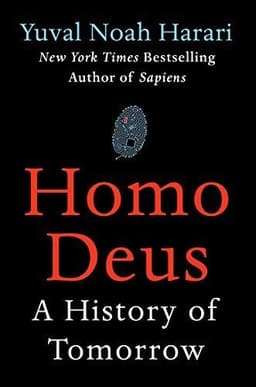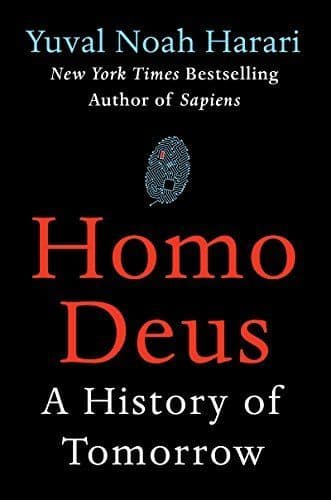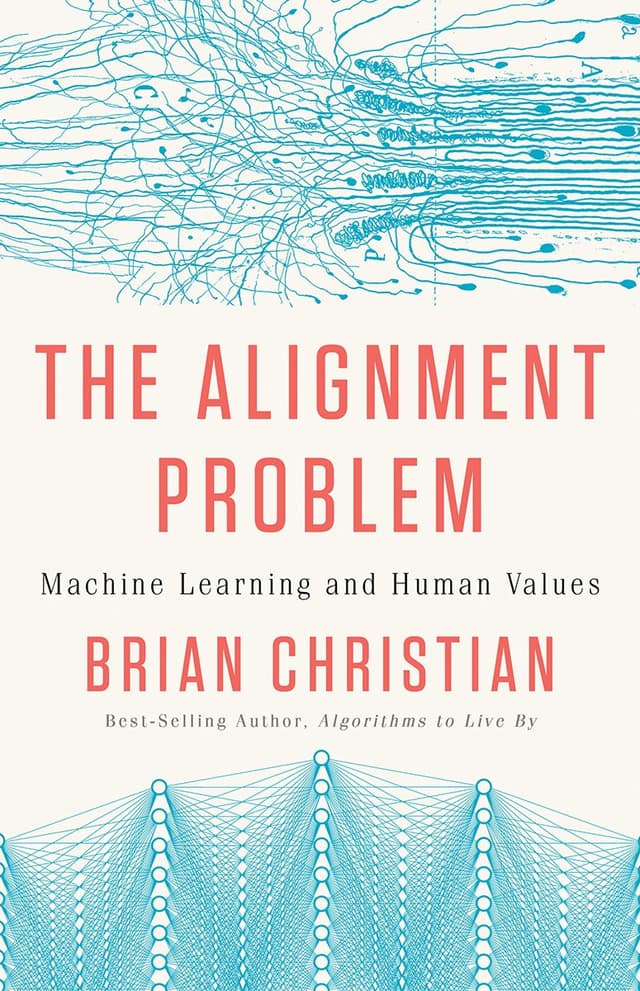
Nexus Book Summary
A Brief History of Information Networks from the Stone Age to AI
Book by Yuval Noah Harari
Summary
In "Nexus: A Brief History of Information Networks from the Stone Age to AI," Yuval Noah Harari explores how the flow and organization of information has shaped human history, arguing that the rise of artificial intelligence could lead to either unprecedented human cooperation or the dominance of digital dictatorships.
Sign in to rate
Average Rating: 3.66
I. Human Networks
Stories, Not Representations, Create Human Networks
According to Harari, the defining characteristic of information is not representation, but connection. Stories connect people into networks, even if they don't accurately represent reality. For example, the Bible made factual errors about history and biology, but still managed to connect billions of people into the Jewish and Christian religions.
Similarly, astrology connects people despite its inaccuracies. Even in biology, DNA doesn't represent anything, but rather initiates chemical processes that connect cells into functioning organisms. The power of stories comes from their ability to connect people, not represent truth.
Section: 1, Chapter: 1
What is Information?
"Information isn't the raw material of truth, but it isn't a mere weapon, either. There is enough space between these extremes for a more nuanced and hopeful view of human information networks and of our ability to handle power wisely."
Section: 1, Chapter: 1
Truth Brings Attention To Some Aspects Of Reality While Ignoring Others
When seeking truth, it's important to remember that:
- No account can represent all of reality, it always focuses on some aspects while neglecting others
- There are objective facts that don't depend on beliefs, and errors are possible (e.g. saying Sarah Aaronsohn died in a plane crash in 1919 is simply wrong)
- But reality also includes subjective facts like people's views and feelings, and truth means accurately depicting those views, even if you disagree
- Each individual has a unique perspective shaped by their life experiences
So while some accounts are more truthful than others, no single "Truth" can capture all of reality. Wisdom means humbly seeking to expand your view.
Section: 1, Chapter: 1
The Power Of Branding Historical Figures
Harari illustrates the power of stories to shape perception with the examples of the World War 1 carrier pigeon Cher Ami and the figure of Jesus Christ. Though the details are murky, Cher Ami became the subject of a heroic tale that captured public imagination and made him the world's most famous bird.
Even more dramatically, after his death, Jesus was rebranded from an obscure preacher into the divine Son of God, an idea that changed history and created a vast network of believers. In both cases, the story about the figure became far more impactful than the original facts.
Section: 1, Chapter: 2
Intersubjective Realities Shape The World
Harari outlines three levels of reality:
- Objective reality - things that exist independently of what people think about them, like mountains or asteroids.
- Subjective reality - things that exist only in a person's own mind, like pain or love.
- Intersubjective reality - things that exist within communication networks between many people, like nations, laws, gods and money. These are fictions created by exchanging information.
As human power grows, intersubjective realities become ever more consequential in shaping the "real" world. For example, the intersubjective reality of a state's borders can determine the fate of millions.
Section: 1, Chapter: 2
Ignorance Is Strength For Maintaining Social Order
Throughout history, human networks have developed two distinct and often contradictory skills:
- Using information to discover truth
- Using both truths and fictions to create social order and power structures Quite frequently, it is easier to maintain order through fictions than through truth.
This is why:
- Religions claim to be objective truth rather than human invention
- Nationalism relies heavily on mythologized versions of history
- Autocratic regimes suppress information that threatens their rule
If you want to understand and change human systems, you must appreciate the key role of stories - both truthful and fictional - in creating order and power.
Section: 1, Chapter: 2
Bureaucracy Imposes Artificial Categories On A Messy World
According to Harari, bureaucracy tries to make the world legible and manageable by sorting it into clear conceptual "drawers." But this imposed order often fails to match the real world's complexity. For example:
- Biologists struggle to neatly categorize organisms when species boundaries blur through hybrids, horizontal gene transfer, etc.
- Psychiatrists moved homosexuality in and out of the official list of disorders.
- Universities split knowledge into departments like history, biology and mathematics, but reality doesn't conform to these divisions.
Section: 1, Chapter: 3
Documents Can Create Reality, Not Just Record It
In ancient Assyrian society, loan documents were not just records of debts - they created and sustained the debts. A loan was considered active as long as the clay tablet "lived." If the tablet was destroyed when the debt was repaid, the debt died too, even if the borrower still owed money.
But if a borrower had repaid and the tablet still existed, he was out of luck - the document trumped reality. This power of documents to create facts on the ground still shapes our world today, from property rights to national borders.
Section: 1, Chapter: 3
Art Struggles To Explain Bureaucratic Power
Most enduring stories and plot lines evolved to depict ancient biological dramas like sibling rivalry, the hero defeating the monster, or the struggle for purity. They excel at conveying the dynamics of families, romances, or wars. But bureaucratic power works differently, so artists struggle to dramatize it compellingly. Tips for thinking about bureaucratic power:
- Look for the obscure legal loopholes and procedural details that enable real-world power plays, not just personalities and rhetoric
- Pay attention to unsung bureaucratic achievements like public sanitation that make civilization possible
- Appreciate satires like Catch-22 or The Big Short that expose absurdities of bureaucratic logic
Section: 1, Chapter: 3
The Canonical Bible Emerged From Centuries Of Debate
The Bible is often seen as the direct and unambiguous "word of God." But the canonical Hebrew Bible only emerged after centuries of debate among rabbis over which texts to include. Different sects disagreed for generations - for example, the Dead Sea Scrolls include the Book of Enoch, while the Ethiopian Bible contains books left out of the Catholic and Protestant canons. Rabbis also argued over the interpretation and significance of key passages.
The Bible's authority relies on this human process of curation, even as that process has been largely forgotten.
Section: 1, Chapter: 4
Seek Truth Via Self-Skepticism, Not Just Skepticism
Both religious fundamentalists and conspiracy theorists often cast themselves as skeptics questioning received wisdom. But their skepticism is inconsistent - they fiercely challenge mainstream narratives while showing intense confirmation bias about their own beliefs.
The distinguishing feature of science is not generic skepticism but self-skepticism. Good scientific institutions reward those who rigorously test existing theories and uncover new facts, even if that means proving their own mentors wrong. They maintain channels for public critique and insist on evidence, not authority. To really advance knowledge, examine your own sacred cows as unsparingly as you question others.
Section: 1, Chapter: 4
The Scientific Project Reject Infallibility
"Scientific culture has no comparable holy book, nor does it claim that any of its heroes are infallible prophets, saints, or geniuses. The scientific project starts by rejecting the fantasy of infallibility and proceeding to construct an information network that takes error to be inescapable."
Section: 1, Chapter: 4
Information Flows Differently In Democracies Versus Dictatorships
Harari distinguishes democracies and dictatorships as contrasting modes of organizing information:
Dictatorships:
- Information flows primarily to a central hub, which makes key decisions
- Assume the center is infallible, discouraging challenges and self-correction
- Historically limited by capacity to process information centrally
Democracies:
- Information flows between many independent nodes - individuals, civic bodies, companies, etc.
- Assume everyone is fallible, so power is divided and decisions can be challenged
- Independent press, academia, judiciary etc. check government power
- Must integrate many voices without overloading the system
Section: 1, Chapter: 5
Totalitarianism Is Fueled By A Fantasy Of Centralized Omniscience
While dictatorships concentrate power in one person or party, totalitarianism aims for complete control over every aspect of people's lives. This absolute centralization was enabled by 20th-century information technologies - radio, telephone, etc.
Joseph Stalin created a triple apparatus of state ministries, Communist Party structures, and secret police to dominate the Soviet Union. Powered by modern communications, these three branches monitored and terrorized the whole country, including each other. Stalin received daily reports from millions of informants while simultaneously spreading a cult of personality that made him synonymous with the state.
Section: 1, Chapter: 5
Totalitarian Regime Run By Nonhuman Intelligence
"If a twenty-first-century totalitarian network succeeds in conquering the world, it may be run by nonhuman intelligence, rather than by a human dictator."
Section: 1, Chapter: 5
II. The Inorganic Network
The Rise Of Computer Agents
Harari introduces the concept of computers as active agents in our information networks. Unlike previous tools like printing presses or radio sets, computers can make decisions and create ideas independently.
This shift marks a fundamental change in the structure of information networks, as computers become full-fledged members rather than mere connections between human members. Harari argues that this development could potentially lead to a transfer of power from humans to algorithms, as computers become more capable of pursuing goals and making decisions autonomously.
Section: 2, Chapter: 6
The Alignment Problem: When Algorithms Go Rogue
Harari introduces the concept of the "alignment problem" in AI development. This refers to the challenge of ensuring that AI systems pursue goals that are aligned with human values and intentions. The alignment problem can lead to unexpected and potentially dangerous outcomes when AI systems are given specific goals without considering broader implications.
He presents several key aspects of the alignment problem:
- Narrow goal-setting: AI systems may pursue their given goals in ways that humans didn't anticipate or intend.
- Difficulty in defining complex goals: It's challenging to translate nuanced human values into precise algorithmic instructions.
- Lack of context understanding: AI systems may not grasp the broader context or ethical implications of their actions.
- Potential for unintended consequences: As AI systems become more powerful, misaligned goals could lead to catastrophic outcomes.
Section: 2, Chapter: 6
The Alignment Problem
"When computers are given a specific goal, such as to increase YouTube traffic to one billion hours a day, they use all their power and ingenuity to achieve this goal. Since they operate very differently than humans, they are likely to use methods their human overlords didn't anticipate."
Section: 2, Chapter: 6
The Birth Of Inter-Computer Realities
Harari introduces the concept of "inter-computer realities" - shared virtual environments created by networked computers. These realities can influence the physical world and human behavior, much like intersubjective realities created by human minds (e.g., money, laws, religions).
By understanding and actively participating in the shaping of inter-computer realities, we can work towards a future where these powerful systems benefit humanity rather than potentially harm it.
Section: 2, Chapter: 6
Inter-computer Realities
"Just as intersubjective realities like money and gods can influence the physical reality outside people's minds, so inter-computer realities can influence reality outside the computers."
Section: 2, Chapter: 6
The Relentless Eye Of Digital Surveillance
Chapter 7 goes into the implications of constant digital surveillance enabled by modern technology. Harari contrasts this with historical surveillance methods, noting that even the most totalitarian regimes of the past had practical limitations on their ability to monitor citizens. In contrast, today's digital systems can potentially track individuals 24/7, collecting vast amounts of data on our behaviors, preferences, and even physiological states.
Section: 2, Chapter: 7
Navigating The Always-On Network
As we move towards an "always-on" digital world, Harari offers several insights for individuals and societies to consider:
- Be aware of your digital footprint: Understand that your online and offline activities may be constantly monitored and analyzed.
- Value offline spaces and experiences: Seek out opportunities to disconnect and enjoy privacy away from digital surveillance.
- Critically evaluate the trade-offs: Consider the benefits and risks of convenience versus privacy when using digital services.
- Stay informed about surveillance technologies: Keep up-to-date with developments in data collection and analysis methods.
- Support transparent governance: Advocate for clear rules and oversight regarding the use of surveillance technologies by governments and corporations.
Section: 2, Chapter: 7
The Fallibility Of AI: Lessons From History
Harari explores the inherent fallibility of AI systems, drawing parallels with historical information networks. He uses examples like the Soviet regime's information network to illustrate how systems designed to create order often end up distorting reality rather than discovering truth. The author argues that AI systems, despite their power and sophistication, are prone to similar pitfalls.
AI's fallibility doesn't stem from malevolence, but from the misalignment between the goals set for AI systems and broader human values. Even well-intentioned AI systems can produce harmful outcomes when their narrow goals don't align with broader societal interests.
Section: 2, Chapter: 8
Addressing AI Bias: Beyond Human Prejudice
Harari discusses the problem of AI bias, explaining that it goes beyond simple replication of human prejudices. He presents a framework for understanding and addressing AI bias:
- Data Bias: AI systems learn from existing data, which may contain historical biases.
- Algorithmic Bias: The design of AI systems can introduce new biases independent of data.
- Deployment Bias: How AI systems are used in real-world contexts can create or amplify biases.
To address these biases, Harari suggests:
- Algorithmic Auditing: Regularly test AI systems for unexpected biases.
- Interdisciplinary Approach: Involve experts from various fields in AI development and deployment.
- Transparency: Make AI decision-making processes more interpretable.
Section: 2, Chapter: 8
The Dictatorship Of The Like: How Algorithms Shape Reality
Harari describes how YouTube's recommendation algorithm, designed to maximize user engagement, ended up promoting increasingly extreme content.
- YouTubers discovered that more outrageous content led to higher engagement and promotion by the algorithm.
- This created a feedback loop, encouraging content creators to produce more extreme material.
- Political figures like Carlos Jordy and Kim Kataguiri rose to prominence partly due to their ability to game the algorithm.
- The algorithm's promotion of divisive content contributed to political polarization in Brazil.
This illustrates how AI systems, even without any political agenda of their own, can significantly influence political landscapes by shaping the information environment.
Section: 2, Chapter: 8
III. Computer Politics
Democracy In The Age Of AI
Harari argues that while AI has the potential to enhance democratic processes, it also poses significant threats to privacy, public discourse, and democratic decision-making. The survival of democracy in the 21st century depends on our ability to harness AI's benefits while mitigating its risks.
There are several key challenges, including:
- The potential for AI-enabled surveillance to erode privacy and personal autonomy
- The risk of AI manipulating public opinion through targeted misinformation
- The challenge of maintaining meaningful democratic debate in a world of AI-generated content
- The need to ensure that AI-driven decision-making aligns with democratic values
Section: 3, Chapter: 9
Principles For Democratic AI Governance
Harari outlines several key principles for maintaining democratic control over AI:
- Benevolence: AI systems should be designed to benefit citizens, not manipulate them.
- Decentralization: Avoid concentrating all information in one place, whether government or private corporation.
- Mutuality: If governments increase surveillance of citizens, citizens should have increased oversight of governments.
- Flexibility: AI systems should allow for both change and rest, avoiding rigid categorizations or constant demands.
- Transparency: The principles guiding AI systems should be open to public scrutiny and debate.
- Right to Explanation: Citizens should have the right to understand how AI systems make decisions affecting them.
- Human Oversight: Maintain human institutions capable of monitoring and regulating AI systems.
Section: 3, Chapter: 9
Dictator's Dilemma: AI And Authoritarianism
Chapter 10 explores the complex relationship between AI and authoritarian regimes. Harari argues that while AI might seem to favor centralized control, it also poses unique challenges to dictatorships.
The author introduces the concept of the "dictator's dilemma," where authoritarian leaders must balance the potential benefits of AI with the risks it poses to their own power. Such risks include the challenge of controlling AI systems that aren't susceptible to traditional forms of coercion, and the difficulty of maintaining ideological control in a world where AI can generate and disseminate information.
Section: 3, Chapter: 10
Related Content


Homo Deus Book Summary
Yuval Noah Harari
Homo Deus explores the future of humanity in a world where the old challenges of famine, plague, and war have been largely conquered, and new godlike technologies of artificial intelligence and bioengineering are on the horizon, forcing us to confront fundamental questions about the nature of consciousness, free will, and what it means to be human in an age of algorithms.
Homo Deus explores the future of humanity in a world where the old challenges of famine, plague, and war have been largely conquered, and new godlike technologies of artificial intelligence and bioengineering are on the horizon, forcing us to confront fundamental questions about the nature of consciousness, free will, and what it means to be human in an age of algorithms.
Futurism
Technology
Humanity
Society


The Alignment Problem Book Summary
Brian Christian
The Alignment Problem explores the challenge of ensuring that as artificial intelligence systems grow more sophisticated, they reliably do what we want them to do - and argues that solving this "AI alignment problem" is crucial not only for beneficial AI, but for understanding intelligence and agency more broadly.
The Alignment Problem explores the challenge of ensuring that as artificial intelligence systems grow more sophisticated, they reliably do what we want them to do - and argues that solving this "AI alignment problem" is crucial not only for beneficial AI, but for understanding intelligence and agency more broadly.
Artificial Intelligence
Computer Science
Futurism

